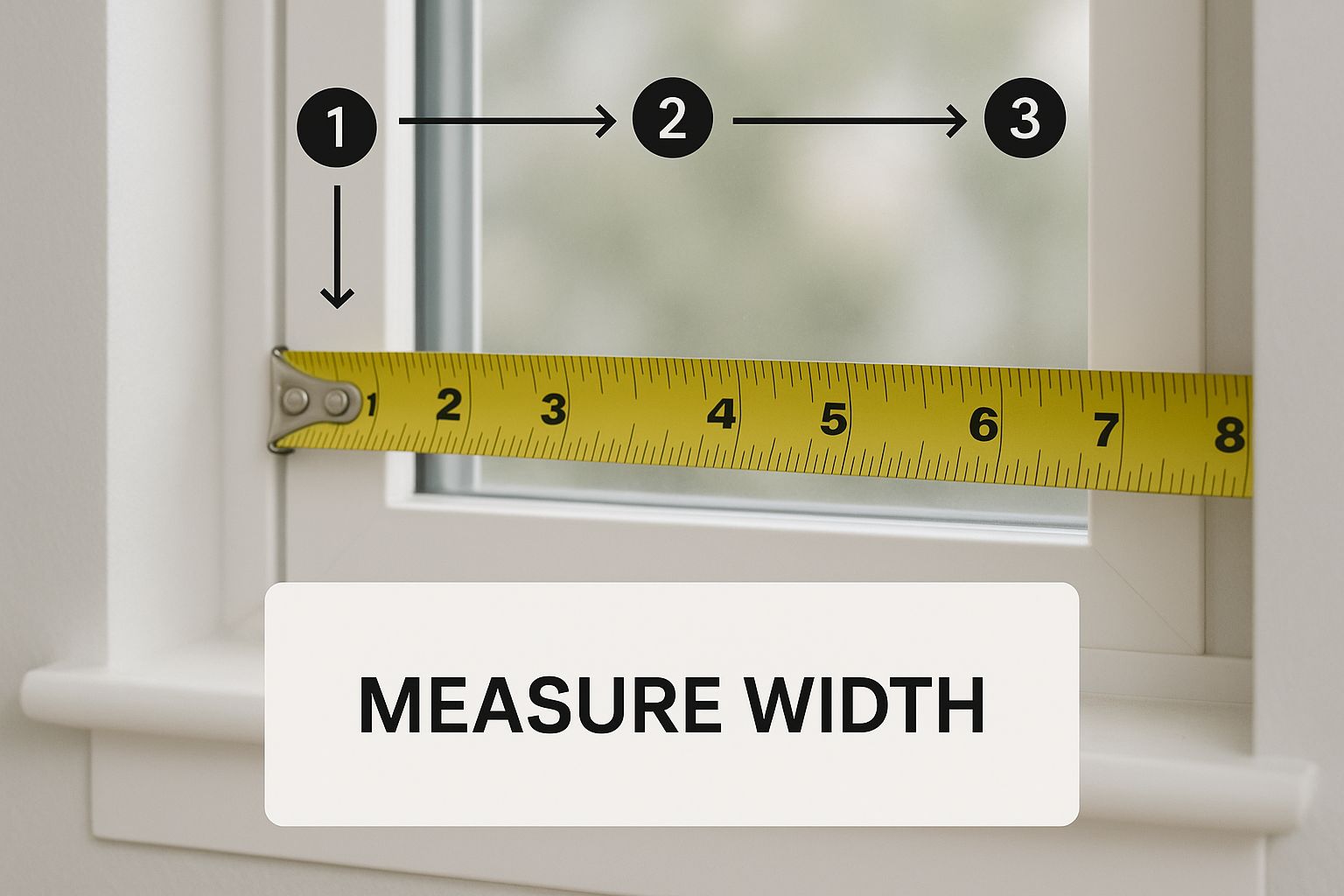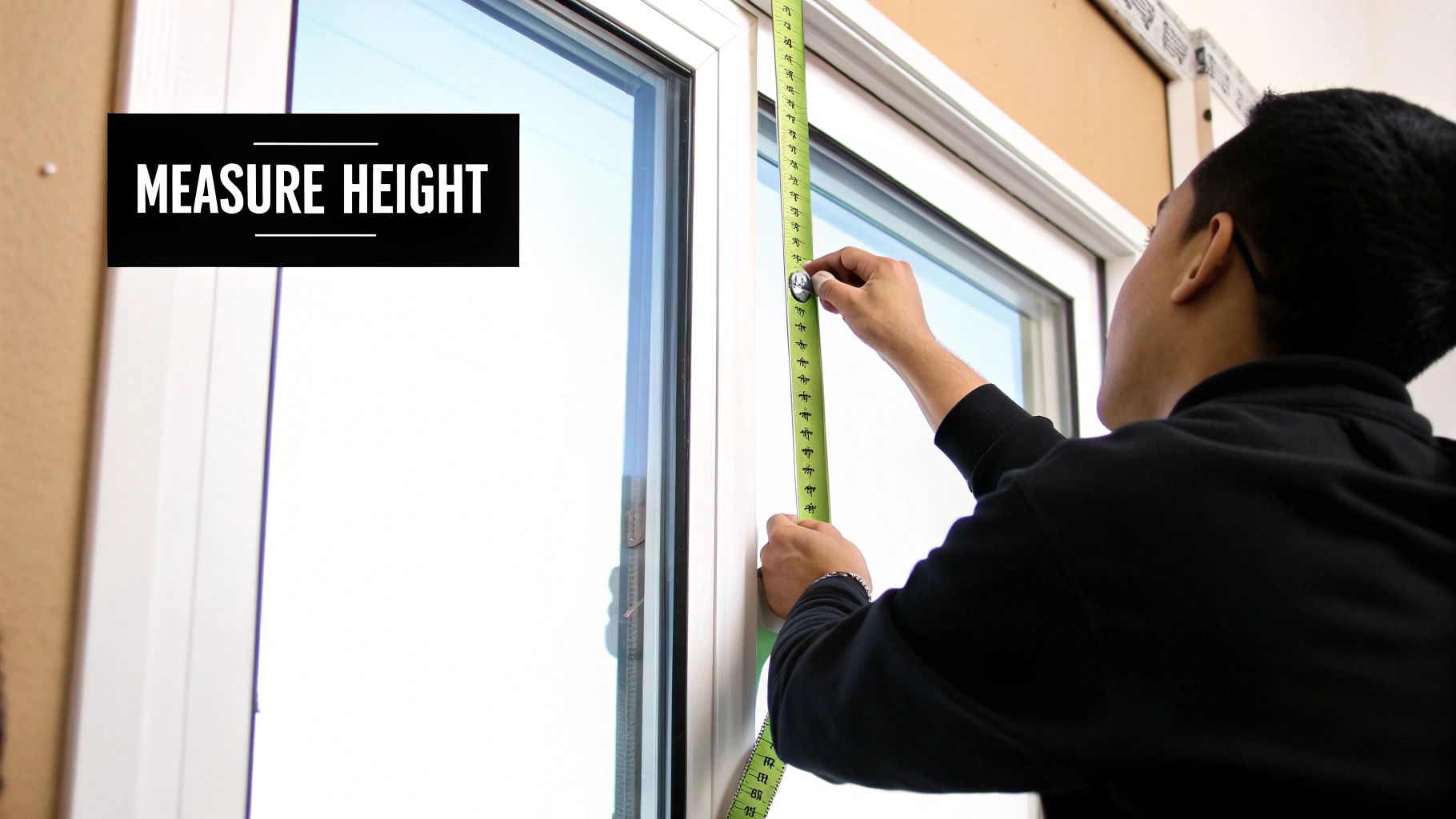How to Measure for Curtains: Expert Tips for Perfect Fit

Why Perfect Curtain Measurements Transform Your Space

Precise curtain measurements are essential for a beautifully dressed window. They’re the key to achieving a polished look, elevating your room's aesthetic. Ill-fitting curtains can detract from your decor, while well-measured ones frame your view elegantly. Taking accurate measurements is the crucial first step in creating the perfect window treatments.
The Impact of Accurate Measurements
Accurate measurements are about more than just aesthetics. They also impact functionality and even energy efficiency. For example, thermal curtains measured correctly can significantly improve insulation, keeping your home warmer in winter and cooler in summer.
This can lead to noticeable savings on your energy bills, a significant advantage given NZ's varying climate. Precisely measured curtains also offer superior light control, protecting your furniture from sun damage and allowing you to set the perfect mood in every room.
The curtains and blinds market in New Zealand is steadily growing, influencing how consumers approach curtain measurement and purchasing. By 2025, this market is projected to reach approximately NZD 135 million. This growth highlights the increasing importance of accurate measurement within the industry. Find more detailed statistics here
Consequences of Measurement Mishaps
Imagine investing in custom-made curtains only to find they're too short or don't close properly. This is a frequent result of inaccurate measurements. These mistakes can be costly, particularly with bespoke options.
Even with ready-made curtains, incorrect measurements often mean returns or exchanges, wasting both time and money. Avoiding these pitfalls starts with careful planning and precise measuring.
Avoiding Common Pitfalls
Measuring for curtains accurately can take practice. However, many common errors are easily avoided with a little attention to detail. Here’s a look at some typical measurement mistakes and how to prevent them:
- Measuring the window, not the track: Always measure the track or rod width, not just the window itself. This ensures full coverage and allows the curtains to stack back neatly.
- Forgetting about fullness: Curtains require extra width for a beautiful drape. Ignoring fullness leads to flat, unappealing curtains.
- Inconsistent measurements: Use a metal tape measure for accuracy and measure each window several times. This is especially important in older NZ homes where walls and windows might not be perfectly square.
The table below summarizes these common mistakes, their consequences, and how to avoid them.
Common Curtain Measurement Mistakes
| Measurement Error | Consequence | How to Avoid |
|---|---|---|
| Measuring only the window opening | Curtains may be too narrow, not covering the entire window or allowing for proper stacking | Measure the track or rod width, extending beyond the window frame on each side |
| Not accounting for fullness | Curtains appear flat and lack proper drape | Calculate the required fullness based on the curtain heading style and fabric type, typically 1.5-2.5 times the track width |
| Inconsistent measurements | Uneven curtain lengths or widths, causing an unprofessional look | Use a metal tape measure and measure each window multiple times, recording the measurements carefully |
This table highlights the crucial aspects of accurate curtain measurement to avoid costly mistakes and achieve the desired look and functionality.
By understanding the importance of accurate measurements and avoiding common mistakes, you can ensure your curtains look fantastic and function perfectly in your NZ home.
Essential Tools and Preparation for Measurement Success
Before you even begin to think about measuring for curtains, preparation is key. Gathering the right tools and understanding the specifics of your New Zealand home's architecture are crucial steps. Just like a builder needs blueprints, you need the proper equipment and a solid plan. This will save you time, money, and the headache of ill-fitting curtains.
Gathering Your Toolkit
Having the proper tools makes measuring more accurate and efficient. Here’s what you’ll need:
- Metal Tape Measure: A retractable metal tape measure is essential for accuracy. Avoid cloth tape measures, as they can stretch and lead to incorrect measurements. This precision is particularly important in character homes common in New Zealand, where walls might not be perfectly even.
- Pencil and Paper: Keep a pencil and paper close by to record your measurements. A small notebook is ideal for keeping everything organized.
- Stepladder: For high windows or long drapes, a sturdy stepladder is crucial for safety and accurate measuring.
- Laser Level (Optional): A laser level can be incredibly helpful for ensuring consistent measurements, especially across wider windows or uneven surfaces often found in older New Zealand villas.
Preparing Your Windows
Before measuring, prepare your windows. Clear any obstructions, such as furniture or plants, that might get in the way. This will give you a clear view and allow for more precise measurements. Also, take note of unique architectural features, like bay windows or ranch sliders, which might require specific measuring techniques. These are common in New Zealand homes and need careful consideration.
Understanding Your Window Style
New Zealand homes have a variety of window styles, each requiring a slightly different approach to measurement. Think about whether you are dealing with standard windows, bay windows, French doors, or ranch sliders. Each has its own set of considerations. For example, bay windows require several measurements due to the angles. Understanding your window type will help you get it right the first time. Learn more in our article about How to master curtain measurements in your NZ home.
Recording Your Measurements
Clear and organized measurement records are essential. Create a simple chart or worksheet to keep track of each window’s dimensions. This will help prevent confusion and ensure you have the correct information when ordering your curtains. This is especially important if you're measuring multiple windows, a common scenario in New Zealand homes. With these essential tools and preparation steps, you'll be well-prepared to get perfectly measured curtains that enhance your space. You might be interested in: How to master choosing colours to match your furniture.
Mastering Curtain Width: Beyond Basic Measurements
Accurate width measurements are the cornerstone of well-fitting curtains. They not only determine how smoothly your curtains function but also significantly impact a room's overall aesthetic. This involves more than just measuring the window itself. It requires understanding professional standards for coverage, stack-back (the space curtains occupy when open), and track positioning to complement various New Zealand home styles.
Considering Stack-Back and Fullness
Stack-back is a critical, often overlooked, factor. It refers to the amount of space your curtains occupy when drawn open. This is particularly important in New Zealand homes, where maximizing natural light is often a priority. A narrow window with limited wall space, for instance, needs less stack-back than a large ranch slider. Before diving into measurements, reviewing some basic measurement principles, like those used for measuring kitchen cabinets, can be beneficial.
Fullness is also key to achieving beautiful drape and avoiding a flat, unappealing look. It’s calculated as a ratio of the track width to the fabric width. This ratio varies based on the heading style. Pencil pleats, for example, typically require a fullness ratio of 2 to 2.5, while eyelet curtains often look best with a ratio of 1.5 to 2.
Handling Tricky Scenarios
New Zealand homes frequently present unique challenges, such as corner windows, expansive glass areas, and multi-panel treatments. These situations demand specialized approaches to width measurement. Corner windows, for example, may require two separate track measurements that overlap slightly to ensure full coverage. Large expanses of glass may benefit from dividing the area into multiple panels, each with its own width calculation.

The infographic above illustrates the fundamental process of measuring width, emphasizing accurate tape measure use across the window frame. It highlights how precise width measurement starts with the window frame, forming the basis for all subsequent calculations.
Professional Tips for Accurate Width Calculation
New Zealand designers use specific formulas to calculate the ideal fullness ratio for each heading style. Accurate curtain measurement is vital for both aesthetics and functionality, especially given the common window sizes and styles in New Zealand homes. Curtain Studio, a prominent New Zealand curtain specialist, recommends adding at least 15 cm to each side of the window frame for optimal coverage. This extra width ensures the curtains clear the window when open and provides ample fabric for a pleasing drape. This is especially important in contemporary New Zealand homes with large glass sliders and classic villas with unique architectural details.
Fabric type is another important consideration. Heavier fabrics typically require a higher fullness ratio than lighter sheers, affecting the overall width calculation. Accurate width measurements allow you to achieve your desired look, whether it’s sleek minimalism or luxurious fullness. For more inspiration, consider exploring resources like how to master choosing colours to match your furniture. By mastering these techniques, you can confidently determine the precise additional width needed, avoiding both the disappointment of skimpy curtains and the cost of excess fabric.
Perfect Length: Creating the Right Curtain Drop Every Time

The drop, or length, of your curtains significantly impacts the overall ambiance of a room. The right drop can elevate a simple window covering into a stylish statement. This guide will walk you through various curtain lengths, helping you select the perfect fit for your New Zealand home. For additional guidance on measuring, check out this helpful resource: How To Measure For Blinds Quick Easy Guide.
Exploring Curtain Length Options
Four classic curtain hanging positions can transform your space:
-
Sill Length: These curtains end neatly at the windowsill. This practical choice suits kitchens, bathrooms, and rooms with furniture placed below the window, offering a clean, uncluttered appearance.
-
Below-Sill Length: Extending just 5-10cm below the sill adds a touch of elegance and works well in various settings. This versatile option provides good coverage without overwhelming the room.
-
Floor Length: Grazing the floor, these curtains offer a classic, sophisticated look. Ideal for living rooms, dining rooms, and bedrooms, they provide a polished and formal feel.
-
Puddle Length: For a luxurious touch, puddle-length curtains extend onto the floor, creating a dramatic "puddle" of fabric. Best suited for formal spaces, these curtains require more upkeep and may not be ideal for high-traffic areas in your NZ home.
Measuring for Different Drops
Accurate measurement is essential once you've chosen your desired length. A metal tape measure is recommended for precision, particularly in older New Zealand homes where surfaces might be uneven. For sill and below-sill lengths, measure from the track's top edge to the windowsill, adding the desired extra length for below-sill curtains.
For floor-length curtains, measure from the top of the track to the floor. Measure in several spots across the window to ensure consistency, especially in character homes with potentially uneven floors. For inspiration on styling, consider this article: How to master decorating with cushions. For puddle length, add the desired excess fabric to your floor-length measurement, ranging from a few inches to a foot or more.
Accommodating Architectural Features and Furniture
New Zealand homes often boast unique architectural details, such as radiators and bay windows. Consider these features when measuring to ensure a seamless fit. Curtains should hang clear of radiators to allow for proper heat circulation. Furniture placement near windows should also influence your curtain length choices.
Addressing Fabric Shrinkage and Track Placement
Fabric shrinkage, especially in humid New Zealand climates, is an important consideration. Natural fabrics like linen or cotton are more susceptible. Account for potential shrinkage by adding 2-5cm to your measurement. The track's placement also affects the final drop. Install it high enough to accommodate the chosen length while maintaining clearance above the window. Careful planning ensures the perfect curtain drop, enhancing both style and function in your home.
Special Techniques for Unique Window Styles and Curtain Types
New Zealand homes often feature distinctive window designs, requiring a tailored approach to measurement. Let's explore common challenges and practical solutions for ensuring your curtains fit perfectly and enhance your home's aesthetic appeal. For more home decor inspiration, take a look at some top green upholstery material ideas.
Measuring for Thermal Curtains
Thermal curtains are a popular choice in NZ, prized for their energy efficiency. Accurate measurements are vital for maximizing their insulating properties. For a truly effective thermal barrier, precise measurements are essential to minimize drafts. When measuring width, consider the track type. Extending the track beyond the window frame enhances coverage and insulation. For length, a slight overlap onto the window frame helps prevent heat loss.
Handling Multi-Panel Bifold Doors
Bifold doors present a unique challenge with their multiple panels. For both functionality and style, consider individual curtain panels for each door section. This approach enhances ease of use and creates a cleaner, more streamlined look. Measure each panel individually, factoring in any overlap or gaps.
Mastering Bay Windows
Bay windows, with their graceful curves and angles, can be tricky to measure accurately. Precision is crucial for a seamless, elegant finish. Treat each section of the bay window as a separate window. Carefully measure the width and length of each section, taking into account the angles and curves. This meticulous approach ensures a perfect fit and complements the bay window’s charm.
Measurement Adjustments for Different Curtain Types
Different heading styles, from traditional pencil pleats to contemporary wave folds and eyelets, require specific measurement adjustments. Understanding these nuances is key to achieving the desired fullness and drape. The following table provides a helpful guide for common curtain styles in New Zealand homes:
Measurement Adjustments for Different Curtain Types
| Curtain Style | Width Adjustment | Length Adjustment | Special Considerations |
|---|---|---|---|
| Pencil Pleats | 2-2.5 times the track width | Measure from the top of the track to desired length | Account for heading tape |
| Eyelet Curtains | 1.5-2 times the track width | Measure from the top of the eyelet ring to desired length | Consider the diameter of the eyelet rings |
| Wave Fold Curtains | 1.5-2 times the track width | Measure from the top of the track to desired length | Account for the specific wave fold track system |
This table summarizes the key adjustments needed for each curtain style, ensuring the correct fullness and a beautiful drape. Remember these adjustments will contribute significantly to the final look and functionality of your curtains.
Layered Window Treatments
Layered window treatments, often combining sheers with blockout curtains, are a popular choice for managing New Zealand's variable light conditions. Precise measurements are essential for layered treatments, ensuring both layers hang correctly and operate smoothly. Measure each layer—sheers and blockouts—separately, following the guidelines for their respective heading styles. Accurate measurements for both layers will result in a polished and functional window treatment.
The New Zealand curtain market primarily caters to domestic demand. Curtain and blind exports represent a tiny fraction (0.001%) of New Zealand's total exports. Learn more about New Zealand's export data. This domestic focus allows for measurement standards tailored to the specific needs and preferences of New Zealand homeowners. This localized approach is important for achieving a perfect fit in the wide array of architectural styles found throughout the country.
From Measurements To Reality: Calculating Fabric Requirements
Converting your precise measurements into the right amount of fabric is crucial for curtain making. It's where many New Zealand homeowners make costly mistakes. But with the right approach, you can confidently translate your measurements into fabric quantities, ensuring a perfect fit and avoiding unnecessary expenses.
Calculating Fabric Width
The first step is determining the total fabric width. This involves considering your track width, desired fullness, and the fabric's width. Fullness refers to the amount of fabric needed for proper drape. A standard fullness ratio is typically between 1.5 and 2.5 times the track width.
For example, if your track measures 200cm and you want a fullness of 2, you'll need 400cm of fabric width.
Pattern matching is another important factor. If your fabric has a large, repeating pattern, you'll need extra fabric for seamless alignment across multiple panels. This can significantly impact your fabric needs, so consult your supplier or their guidelines.
Calculating Fabric Length
Calculating fabric length is simpler. It involves adding allowances for hems and heading tape to your desired drop length. Typically, allow 10-15cm at the top for the heading tape and 5-10cm at the bottom for the hem.
For example, if your desired drop is 240cm, you’ll need approximately 260-270cm of fabric length.
Understanding Fabric Width Limitations And Heading Type Multipliers
Fabric comes in standard widths, commonly 140cm or 150cm in New Zealand. If your calculated fabric width exceeds the standard width, you'll need multiple panels. Carefully consider your measurements and the fabric's width to avoid miscalculations.
Different heading styles, like pencil pleats or eyelet curtains, also influence calculations. Each heading type has a specific multiplier that affects the fabric needed. These multipliers are incorporated into your calculations to avoid a skimpy or overdone look.
Navigating NZ Suppliers’ Fabric Calculators
Many New Zealand fabric suppliers offer online calculators to help determine fabric requirements. These tools simplify the process, but understanding their assumptions is essential. Some calculators might not account for pattern matching or specific heading types.
Always double-check the calculator's assumptions against your own calculations to ensure accuracy and avoid potential shortages or waste.
Accounting For Shrinkage And Heading Tape Dimensions
Fabric, especially natural fibers, can shrink after washing. Factor in potential shrinkage, especially in New Zealand's humid climate, by adding 2-5cm to your length measurement. This ensures the curtains maintain their desired length after cleaning.
Also, consider the heading tape's dimensions, as this affects the final curtain length. Different heading tapes add varying lengths to the top of the curtain.
Troubleshooting Measurement Inconsistencies And Communicating With Suppliers
If you encounter inconsistencies during calculations, re-measure and double-check your initial measurements. Even small discrepancies can impact the final outcome.
When ordering custom curtains, clear communication with your supplier is vital. Providing precise measurements, fabric choice, and heading style preferences helps avoid misinterpretations and ensures your curtains are made to your exact specifications.
Ready to transform your space with beautiful, perfectly fitted curtains? Explore our exquisite range of fabrics and custom design options at Maak Home and bring your vision to life.









